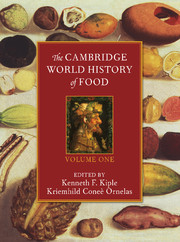Book contents
- Frontmatter
- Introduction
- Part I Determining What Our Ancestors Ate
- Part II Staple Foods: Domesticated Plants and Animals
- Part III Dietary Liquids
- III.1 Beer and Ale
- III.2 Breast Milk and Artificial Infant Feeding
- III.3 Cacao
- III.4 Coffee
- III.5 Distilled Beverages
- III.6 Kava
- III.7 Khat
- III.8 Kola Nut
- III.9 Milk and Dairy Products
- III.10 Soft Drinks
- III.11 Tea
- III.12 Water
- III.13 Wine
- Part IV The Nutrients – Deficiencies, Surfeits, and Food-Related Disorders
- References
III.8 - Kola Nut
from Part III - Dietary Liquids
Published online by Cambridge University Press: 28 March 2008
- Frontmatter
- Introduction
- Part I Determining What Our Ancestors Ate
- Part II Staple Foods: Domesticated Plants and Animals
- Part III Dietary Liquids
- III.1 Beer and Ale
- III.2 Breast Milk and Artificial Infant Feeding
- III.3 Cacao
- III.4 Coffee
- III.5 Distilled Beverages
- III.6 Kava
- III.7 Khat
- III.8 Kola Nut
- III.9 Milk and Dairy Products
- III.10 Soft Drinks
- III.11 Tea
- III.12 Water
- III.13 Wine
- Part IV The Nutrients – Deficiencies, Surfeits, and Food-Related Disorders
- References
Summary
Kola nut is an important stimulant and masticatory in Africa. It is about the size of a walnut or a chestnut and varies in color from dark red to creamy white (Chevalier and Perrot 1911; Cohen 1966;Agiri 1972; Lovejoy 1977–8, 1980). This fruit of the kola tree grows in pods that contain from 3 to 15 or more nuts. Pink and white nuts are generally valued highest because they have a sweeter taste and a greater caffeine content than other kola nuts. Kola is richer in caffeine than coffee and most teas and has 3 times as much starch as cacao (Heckel and Schlagdenhauffen 1884; Kraemer 1910; Chevalier and Perrot 1911; Pratt and Youngken 1956; Ramstad 1959). Known by various African names – goro or gourou, ombéné, nangoué, kokkorokou, and matrasa – kola is known as a heart stimulant because it contains kolanin along with caffeine, traces of the alkaloid theobromine (which exists in cacao as well), glucose, and strychnine (Table III.8.1). Both caffeine and theobromine stimulate the nervous system and the skeletal muscles, making kola a psychoactive substance (Kennedy 1987; Jones 1995).
Kola Production
The genus Cola is of tropical African origin (Freeman 1893; Irvine 1948; Cohen 1966; Dickson 1969) and belongs to the Sterculiaceae family, the species of which are most abundant in tropical Asia (Oliver 1868; Heckel and Schlagdenhauffen 1884). A number of different species grow in the region between Sierra Leone and the Congo (Heckel and Schlagdenhauffen 1884; Kreiger 1954; Kola 1957; Dickson 1969; Morgan and Pugh 1969; Brooks 1980; Anquandah 1982). But of some 40 varieties, only Cola nitida and Cola acuminata are well known and widely used. The former was the kola of long-distance trade, whereas the latter was grown mainly for local consumption in the forest regions of Africa.
- Type
- Chapter
- Information
- The Cambridge World History of Food , pp. 684 - 692Publisher: Cambridge University PressPrint publication year: 2000
References
- 4
- Cited by

